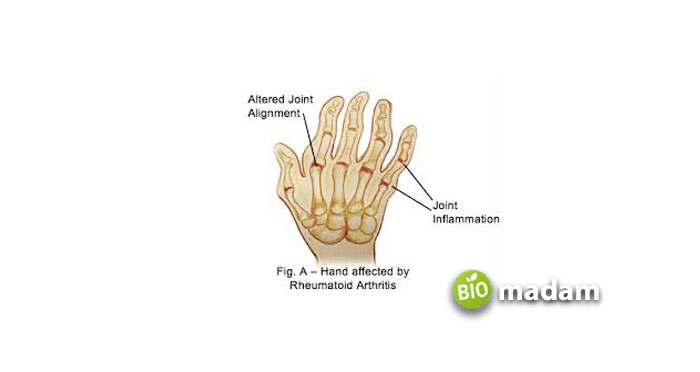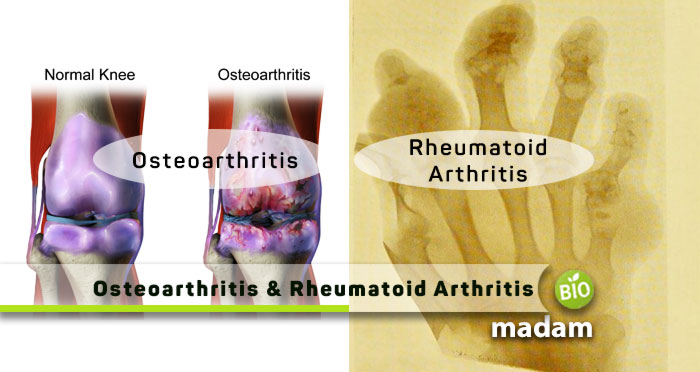Arthritis is a wide term used to describe different forms of joint inflammation. It can be due to various reasons like wear and tear of the joints, age, obesity, or an autoimmune disorder. Joints are essential for movement and maintaining the structure of the body. If they are damaged or inflamed, it can lead to serious issues like loss of mobility and immense pain during movement. The main difference between osteoarthritis and rheumatoid arthritis is that the former occurs due to the wearing off of cartilage, and the latter is an autoimmune disorder.
Comparison Table
| Characteristics | Osteoarthritis | Rheumatoid Arthritis |
| Causes | Wear & tear over time | Autoimmune disease |
| Age | Mostly 45+ | Any age |
| Gender Demographics | Men<45 years of age, women>45 years of age | Women |
| Onset | Slow | Rapid |
| Location | One | Multiple |
| Effect | Degenerative | Systemic |
| Symptoms | Joint pain, swelling, crackling | Joint weakness, body pain, and low-grade fever |
| Morning Stiffness | <1 hour | >1 hour |
| Affected Joints | Fingers, hands, hips, knee, spine | Fingers leading to symmetrical progression |
What is Arthritis?
Arthritis literally translates to joint inflammation. Joint inflammation is not a particular disease or infection in itself. Instead, it is a symptom of worsening joint conditions due to an underlying reason. Arthritis refers to any disorder that affects the joints between two bones. Besides joints, arthritis also exhibits itself in other organs like the skin, eyes, or heart. There are over a hundred types of arthritis, including reactive arthritis, juvenile arthritis, gout, osteoarthritis, and rheumatoid arthritis. Osteoarthritis and Rheumatoid arthritis are the two most common forms of arthritis.
Symptoms of Arthritis
- Joint pain
- Trouble in movement
- Weight loss
- Swelling in joints
- Breathing problems
- Rashes and itching
What is Osteoarthritis?
People often confuse rheumatoid arthritis and osteoporosis with osteoarthritis, but the diseases are different. Osteoarthritis is also commonly known as wear-and-tear arthritis. It occurs over time when the cartilage breaks down. Cartilage is the flexible tissue present between joints. When cartilage reduces, the joints lose the soft padding between them. The loss of padding causes joint membrane (the synovial membrane) inflammation. Besides inflammation, the bones rub against each other, causing swelling and joint pain. The onset of osteoarthritis is slow. It is most common in the knees, hips, hands, and neck.

Symptoms of Osteoarthritis
Due to different underlying causes, the symptoms of Osteoarthritis and Rheumatoid arthritis are different. Osteoarthritis commonly depicts swelling and pain in joints. Other symptoms of osteoarthritis are:
- Morning stiffness
- Joint pain
- Muscle weakness around the joint
- Popping of joints
- Deformed joints
Diagnosis of Osteoarthritis
Physicians carry out physical examinations and check past medical history to evaluate osteoarthritis. Diagnostic tests to diagnose osteoarthritis include:
- Ultrasound to study the tendons and ligaments
- Evaluation of synovial fluid
- Arthroscopy
- Closed synovial biopsy
What is Rheumatoid Arthritis?
Rheumatoid arthritis is another form of arthritis, but it is independent of age as opposed to osteoarthritis. It is considered a systemic disease and can attack multiple joints at once. Rheumatoid arthritis, like the psoriatic arthritis, is an autoimmune disorder that affects the hands, wrists, elbows, knees, ankles, and feet. It can also affect other organs like the cardiovascular system and respiratory systems. The immune system attacks the synovial membrane and causes inflammation in joints. However, the reason behind the autoimmune reaction is unknown.

Symptoms of Rheumatoid Arthritis
As rheumatoid arthritis is systemic, symptoms apart from joint pain and swelling also occur. Symptoms of Rheumatoid Arthritis include:
- Weak joints and muscles
- Warmth in joints
- Overall body pain
- Low-grade fever
- Joint stiffness
Diagnosis of Rheumatoid Arthritis
If you suspect swelling in your joints with body pain and low-grade fever, it is best to consult a doctor. Physicians typically conduct the following tests to evaluate rheumatoid arthritis.
- C-reactive protein (CRP) test
- Rheumatoid factor test
- Anti-cyclic citrullinated peptide (anti-CCP) test
- X-ray and MRI
Similarities Between Osteoarthritis and Rheumatoid Arthritis
- Both diseases affect the joints primarily.
- Osteoarthritis and rheumatoid arthritis may run in families.
- Weight loss can help relieve their signs and symptoms.
- These conditions cannot be reversed.
Differences Between Osteoarthritis and Rheumatoid Arthritis
Definition
Osteoarthritis
Osteoarthritis is a joint disease caused by the wear and tear of joints over the years.
Rheumatoid Arthritis
Rheumatoid arthritis is an autoimmune disease depicting symptoms systemically.
Causes
Osteoarthritis
Osteoarthritis is caused as a person ages due to wear and tear in joints.
Rheumatoid Arthritis
On the other hand, rheumatoid arthritis occurs as the result of an autoimmune reaction in the body.
Age
Osteoarthritis
Osteoarthritis commonly occurs in old age.
Rheumatoid Arthritis
Whereas rheumatoid arthritis can occur at any age.
Gender Demographics
Osteoarthritis
Osteoarthritis is more common in men under 45 and women over 45 years.
Rheumatoid Arthritis
Alternatively, rheumatoid arthritis is more prevalent in women.
Onset
Osteoarthritis
Osteoarthritis occurs due to the degradation of joint cartilage over a long period.
Rheumatoid Arthritis
Conversely, rheumatoid arthritis has a quick onset of action and shows symptoms quite quickly.
Effect
Osteoarthritis
Osteoarthritis is a degenerative joint disease.
Rheumatoid Arthritis
At the same time, rheumatoid arthritis is a systemic disease caused by an autoimmune reaction.
Location
Osteoarthritis
It typically occurs locally and affects one joint at a time.
Rheumatoid Arthritis
However, rheumatoid arthritis progresses symmetrically and may affect more than one joint simultaneously.
Symptoms
Osteoarthritis
The symptoms of osteoarthritis include swelling of joints, muscle weakness, and popping and crackling joints.
Rheumatoid Arthritis
Symptoms of Rheumatoid arthritis are low-grade fever, body pain, and weakness in joints and muscles.
Morning Stiffness
Osteoarthritis
Morning stiffness lasts for less than an hour and may occur again during the day.
Rheumatoid Arthritis
On the contrary, morning stiffness in joints lasts for more than one hour.
Affected Joints
Osteoarthritis
Osteoarthritis occurs in the fingers and hands. It may also lead to knees, hips, and spine.
Rheumatoid Arthritis
Conversely, rheumatoid arthritis usually begins in smaller joints like the fingers and progresses symmetrically.
The Bottom Line
Osteoarthritis and rheumatoid arthritis are joint inflammation disorders. Osteoarthritis occurs in old age, while rheumatoid arthritis may present at any age. One of the fundamental differences between osteoarthritis and rheumatoid arthritis is the underlying cause. Women are more susceptible to rheumatoid arthritis. It is a systemic autoimmune disorder. Alternatively, osteoarthritis occurs in joints locally. It is a disease of old age. They cannot be treated, but you can manage them with painkillers and an improved lifestyle.
FAQs
Can you have both Osteoarthritis and Rheumatoid arthritis?
Yes, it is possible to have one disease or condition following the other. People with rheumatoid arthritis can get osteoarthritis due to age. Similarly, people over 65 years of age may have elderly-onset RA. It majorly affects larger joints.
Which is worse, osteoarthritis or rheumatoid arthritis?
Arthritis in any form can be painful. However, rheumatoid arthritis processes swiftly compared to osteoarthritis. It is difficult to predict and affects multiple joints at once. Unlike RA, osteoarthritis typically affects one joint at one time.
What is the treatment of arthritis?
Unfortunately, both joint conditions are irreversible, and there is no cure. However, you can take medication to manage the symptoms. Common drugs used for osteoarthritis are NSAIDs and acetaminophen. On the other hand, DMARDs and steroids help with rheumatoid arthritis.

Hello, I would like to introduce myself to you! I am Chelsea Rogers, an experienced blog writer for science articles, holding an MPhil degree. My enthusiasm to grab the best knowledge, let it relate to botany, zoology, or any other science branch. Read my articles & let me wait for your words s in the comment section.

